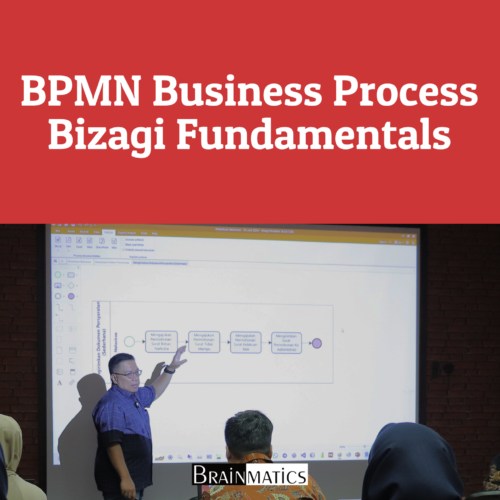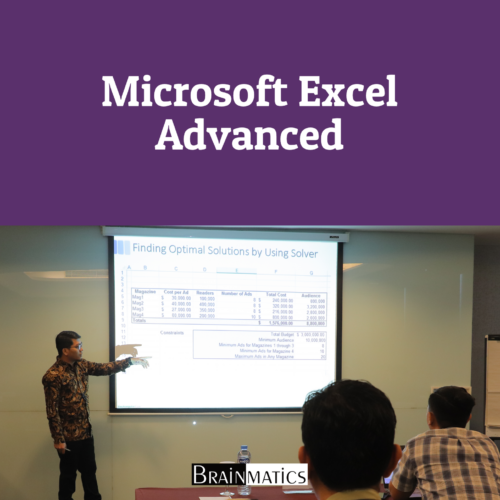![]() BPMN Case Study Training adalah course yang dirancang untuk memberikan pemahaman praktis tentang Business Process Model and Notation (BPMN) melalui studi kasus nyata. Dalam course ini, peserta akan belajar bagaimana menggunakan BPMN untuk memodelkan, menganalisis, dan mengoptimalkan proses bisnis dalam berbagai industri. Dengan pendekatan berbasis studi kasus, peserta akan mendapatkan pengalaman langsung dalam menerapkan BPMN untuk meningkatkan efisiensi dan efektivitas operasional perusahaan.
BPMN Case Study Training adalah course yang dirancang untuk memberikan pemahaman praktis tentang Business Process Model and Notation (BPMN) melalui studi kasus nyata. Dalam course ini, peserta akan belajar bagaimana menggunakan BPMN untuk memodelkan, menganalisis, dan mengoptimalkan proses bisnis dalam berbagai industri. Dengan pendekatan berbasis studi kasus, peserta akan mendapatkan pengalaman langsung dalam menerapkan BPMN untuk meningkatkan efisiensi dan efektivitas operasional perusahaan.
Course ini mencakup berbagai aspek penting dari BPMN, termasuk simbol dan notasi dasar, teknik pemodelan proses, serta cara mengidentifikasi dan mengatasi hambatan dalam proses bisnis. Melalui studi kasus yang relevan, peserta akan memahami bagaimana BPMN digunakan dalam skenario bisnis yang kompleks, mulai dari perbaikan alur kerja hingga otomatisasi proses. Dengan latihan langsung dan diskusi kelompok, peserta akan mendapatkan wawasan praktis tentang bagaimana BPMN dapat membantu organisasi mencapai keunggulan operasional.
Setelah mengikuti course ini, peserta akan mampu membuat diagram BPMN yang sesuai dengan standar industri, memahami bagaimana proses bisnis dapat dioptimalkan, serta mengaplikasikan BPMN dalam proyek transformasi digital. Course ini sangat cocok untuk business analysts, process managers, IT professionals, dan decision-makers yang ingin mengembangkan keterampilan dalam pemodelan dan manajemen proses bisnis menggunakan BPMN.
OBJECTIVES
1. Memahami Konsep dan Notasi BPMN
2.Meningkatkan Keterampilan Pemodelan Proses Bisnis
3. Menganalisis dan Mengoptimalkan Proses Bisnis
4. Menerapkan BPMN dalam Studi Kasus Nyata
5. Mendukung Transformasi Digital dan Automasi
AUDIENCE
1. Chief Information Officer
2. Enterprise Architect
3. Project Manager
4. Manager
5. IT Manager
6. Business Analyst
7. Systems Analyst
PREREQUISITES
Business Process Model and Notation (BPMN)
CONTENT
1. Enterprise Systems
1.1. Apa dan Mengapa EA?
1.2. EA Systems Thinking
2. Characteristics of Business Processes
2.1 Business Process
2.2 Process Performance
2.3 Process Cycle Time
2.4 Process Costs
2.5 Process Quality
2.6 Measuring Process Performance
3. System Theory
3.1 Systems Thinking
3.2 Systems Engineering
3.3 Systems Architecting
3.4 Enterprise Processes
4. Enterprise Architecture
4.1 Architecture
4.2 Viewpoints and Views
4.3 Perspectives
4.4 Enterprise Architecture Frameworks
5. Process Architecture
5.1 Change
5.2 Process Architecture
5.3 Reference Process Architecture: Workflow Systems
5.4 Workflow Reference Model
6. Enterprise Modeling
6.1 Model
6.2 Modeling
6.3 Requirements of Modeling
6.4 Enterprise Modeling
6.5 Process Modeling
6.6 Process Description for Storing Business Process Models
7. Distributed Systems
7.2 Distributed Databases
8. Service-Oriented Architecture
8.1 Service-Oriented Architecture
8.2 Service-Oriented Architecture Benefits
8.3 Characteristics of Service-Oriented Architecture
8.4 Service-Oriented Architecture Applications
8.5 Service-Oriented Architecture Ingredients
8.6 Enterprise Service Bus
9. Cloud Computing
9.1 Cloud Definition
9.2 Cloud Characteristics
9.3 Cloud Delivery Models
9.4 Cloud Deployment Models
9.5 Cloud Benefits
9.6 Cloud Technologies
9.7 Business Processes with Service-Oriented Architecture
10. Business Process Management Systems
10.1 Process-Oriented Enterprise
10.2 History of Business Process Management
10.3 Business Process Life Cycle
10.4 Concept of Business Process Management
10.5 Business Process Management
10.6 Management by Collaboration
10.7 Business Process Maturity Model
10.8 Business Process Management Systems
10.9 Enterprise Process Management Systems
11. Business Process Modeling and Notation
11.1 Business Process Modeling and Notation Core Elements
11.2 Exception Handling
11.3 Transactions
11.4 Sample Purchasing Scenario Represented in Business Process Modeling
and Notation
11.5 Characteristics of Business Process Modeling and Notation for Modeling
Software Engineering Processes
11.6 Spreadsheet-Based Process Modeling
12. Development of Process-Centric Application Systems
12.1 Deductive Databases
12.2 Deductive Spreadsheet
12.3 Spreadsheet Application Development Methodology
12.3.2 Process Modeling
12.3.3 Process Improvement and Innovation
12.3.4 System Development
12.3.5 Maintenance
13. Engineering of Process-Centric Application Systems
13.1 Model-Driven Development
13.2 Process-Centric Applications
13.3 Process-Centric Applications Architecture
13.4 SAP Process Orchestration
14. EPMS for Business Process Analysis
14.1 Queuing Systems
14.2 Queuing Models
14.3 Simulation
14.4 Process Analytics
15. EPMS for Business Process Improvement
15.1 Business Process Reengineering
15.2 Enterprise Business Process Redesign or Reengineering Methodology
15.3 Enterprise-Wide Continuous Improvement Programs
15.4 Time-Based Competition
16. EPMS for Customer Conversations
16.1 Business Processes and Human Interactions
16.2 Interactions and the Quality of Experience
16.3 Customer Interaction Systems
16.4 Implementing Customer Interaction Systems
Course Features
- Lectures 0
- Quizzes 0
- Duration 24 hours
- Skill level All levels
- Language English
- Students 0
- Certificate No
- Assessments Yes









